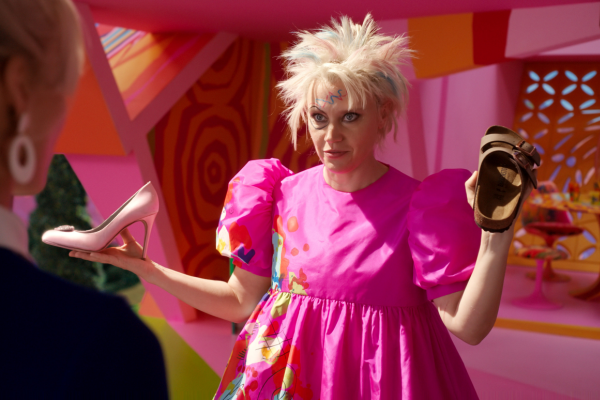The billion-dollar Barbie film had a mega-full-dreamhouse amount of queer references throughout it and its messages about womanhood, misogyny, systems of power, choice, motherhood, horses, and other lofty themes run deep. There are many messages about queerness, but one that’s stuck with me is that Barbie needed to use lesbian stereotypes—the Birkenstock, singing “Closer to Fine”—to reach the Real World. Sapphic symbols were the keys to what she thought would be freedom (though the Real World ended up being a gateway to the patriarchy).
However, back in Barbieland, Kate McKinnon‘s Weird Barbie—the one to continue to represent lesbian symbolism—is the one in the Barbie world to continue to offer a path to freedom. Queerness is a beacon, model, and safe haven for the Barbies throughout the movie. It’s queer Weird Barbie who encourages Barbie to choose the Birkenstock (queer freedom) instead of the high heel (heteronormativity).
When the Kens have been corrupted by the patriarchy of the Real World, the un-brainwashed Barbies go to Weird Barbie’s house. Weird Barbie is dripping in sapphic coding. She has short, spiky hair. She does the splits, a reference to how we all made our Barbies scissor. She wears dykey boots and a ring of Barbie-leg keys. Her house, apart from Barbieland like the social outcasts queer people would be in such a heteronormative world, is colorful instead of just pink and two queer Kens live there with her like it is a LGBTQ+ safe haven. Having an appearance by Earring Magic Ken, the infamous discontinued super-gay Ken from the 1990s gave me life.
When the straight-presenting Barbies go to this multi-color house for help, they aren’t shunned by the queer people like they had shunned the queer people before. Just like happened in the movement for women’s rights in real life when lesbians were discriminated against by a feminist movement that feared appearing man-hating by being inclusive of lesbians, lesbians still showed up and were leaders in the movement for women’s liberation. Weird Barbie lends her invaluable knowledge she only could have gained as an outsider, having created a map of Barbieland by observing from the edges. She helps the Barbies who had “called her weird behind her back and also to her face” because she is still a Barbie woman too, and their liberation is her liberation. She fights alongside them for her rights despite how the other women have treated her, just like queer women have done in social justice movements in reality.
The other character outside of the Barbie/Ken binary is Michael Cera’s Alan. Many trans and nonbinary people have been identifying with him, as have queer men and queer women, for some in part for not feeling they ever fit in to that binary. Alan feels more comfortable with the Barbies than the Kens and is more welcomed by the Barbies than the Kens. Alan is also at Weird Barbie’s house in the planning of the uprising, aligned with queerness. By the end of the movie, all of the women are celebrating the fall of Kendom… all of the women, plus Alan. He may present as a man, but he is aligned with women. Again, a queer-coded character is a leader in the movement for liberation.
The presumed-straight Barbies use these characters’ help and also queer cultural touchpoints like Brandi Carlile and her wife singing the Indigo Girls’ “Closer to Fine” and still maintain their safety of their pink lives with Kens at the end. Nevertheless, queerness’s influence has helped to break down gender roles more than before and to end the brainwashing of women’s subservience to men. I left the Barbie movie inspired as a woman, but reflecting further, inspired as a queer person, too.


